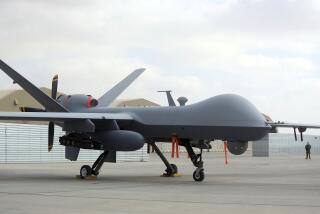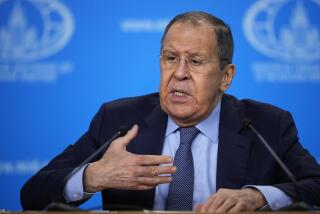Soviets Propose Reducing Risks of Naval Clash
- Share via
MOSCOW — Warning that the risks of armed conflict between the United States and the Soviet Union are now greatest on the high seas, the chief of staff of the Soviet armed forces Monday proposed a series of far-reaching measures to reduce the danger of a naval confrontation between the two superpowers.
Marshal Sergei F. Akhromeyev, writing in the Communist Party newspaper Pravda, said that Moscow would place a high priority in future arms control negotiations on reducing naval forces and sharply limiting their activities.
The continuing growth of naval forces, he said, makes them “a factor that increasingly destabilizes the international situation both on a global and on a regional scale,” particularly since only their strategic nuclear capability is now subject to arms control agreements.
Measures to Be Proposed
In forthcoming talks with the United States and its North Atlantic Treaty Organization allies, the Soviet Union plans to propose a number of naval “confidence-building measures,” similar to those now covering land forces, and then to press for negotiations on naval reductions, Akhromeyev said.
Among the Soviet proposals described by Akhromeyev as “feasible and practical” are these:
-- Restricting missile-carrying submarines to certain areas of the ocean that would in turn be closed to specialized anti-submarine warfare vessels.
-- Prohibition of missile-carrying surface ships of one country from approaching another’s coast within the range of the ships’ missiles.
-- Prohibitions on naval activities in agreed international sea lanes, straits, shipping areas and fishing zones.
-- Prohibition of the deployment of amphibious craft and landing forces within reach of the other’s coast to prevent surprise attacks.
-- Notice of large-scale naval maneuvers with the participation of foreign observers, much as NATO and Warsaw Pact countries now do with ground maneuvers; limits on the size and number of major naval maneuvers, and perhaps inspection of each other’s ships and shore facilities.
Akhromeyev’s proposals, spelled out in a long and candid appraisal of the American and Soviet navies, followed a recent prediction by Adm. William J. Crowe Jr., the chairman of the U.S. Joint Chiefs of Staff and Akhromeyev’s counterpart, that naval forces would figure more prominently in arms control negotiations.
Crowe Tells Concerns
“I am convinced that, as we get more and more into conventional weapons, the Soviet Union is going to make a run on our navy,” Crowe said two months ago, anticipating Akhromeyev’s demand that the United States pull its naval battle groups back from approaches to the Soviet Union.
Soviet officials, explaining Akhromeyev’s position, note that over the past six years, U.S. naval battle groups with two--and sometimes three--aircraft carriers have begun operating in the Norwegian Sea, off the Soviet Pacific coast near Vladivostok, in the Sea of Okhotsk and in the Sea of Japan.
“Nobody presses the United States to leave its sea lanes unprotected,” Akhromeyev said in Pravda. “It has everything necessary for this protection. Besides, the Soviet Union proposes starting negotiations and reducing, although certainly on a mutual basis, those forces of the Soviet naval fleet that cause concern for the United States.”
Foresees U.S. Objections
Akhromeyev, a leading Soviet figure in arms negotiations with the United States, acknowledged that Washington will probably object that such measures would hurt the American fleet more than the Soviet armada, but this, he said, is the same argument that NATO rejects when put forward by the Warsaw Pact on tanks and other armored deployments in Europe.
The United States, Akhromeyev contended, must be “prepared to take into account the legitimate concerns of the other side,” and for the Soviet Union those include U.S. naval deployments, particularly those within striking distance of the Soviet coast.
The reason, as Akhromeyev candidly acknowledged, is continued Soviet inferiority despite a 40-year effort to match U.S. naval power.
By Akhromeyev’s estimate, NATO has 2 1/2-to-7 1/2 times the power of the Warsaw Pact in virtually every category of naval strength except submarines and coastal craft, where it has a slight advantage.
“Overall, the superiority of NATO and of the U.S. Navy is very great,” he said. “That is why the U.S. so signally lacks the desire to cut its naval force and to agree to mutual limits.”
More to Read
Sign up for Essential California
The most important California stories and recommendations in your inbox every morning.
You may occasionally receive promotional content from the Los Angeles Times.













